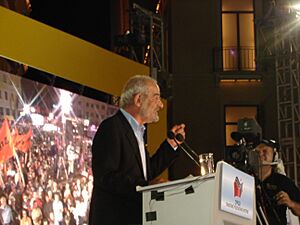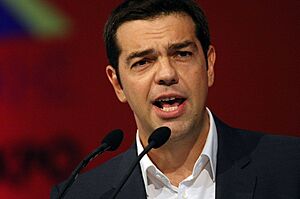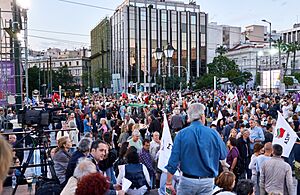Syriza facts for kids
Quick facts for kids <div style="padding-top:0.3em; padding-bottom:0.3em; border-top:2px solid Lua error in Module:European_and_national_party_data/config at line 227: attempt to index field 'data' (a nil value).; border-bottom:2px solid Lua error in Module:European_and_national_party_data/config at line 227: attempt to index field 'data' (a nil value).; line-height: 1;">
Coalition of the Radical Left – Progressive Alliance
Συνασπισμός Ριζοσπαστικής Αριστεράς – Προοδευτική Συμμαχία
Sinaspismós Rizospastikís Aristerás – Proodeftikí Simachía |
|
|---|---|
 |
|
| Abbreviation | SYRIZA ΣΥΡΙΖΑ |
| President | Sokratis Famellos |
| General Secretary | Rania Svigkou |
| Press Representative | Pausanias Papageorgiou |
| Founded | 15 January 2004 |
| Registered | 22 May 2012 |
| Preceded by | Synaspismos |
| Headquarters | Eleftherias Sq. 1, 105 53 Athens |
| Newspaper | I Avgi |
| Think tank | Nicos Poulantzas Institute |
| Youth wing | SYRIZA Youth |
| Membership (2023) | |
| Ideology |
|
| Political position | Centre-left to left-wing |
| European affiliation | Party of the European Left |
| European Parliament group | The Left in the European Parliament |
| Colours | Pink |
| Hellenic Parliament | Lua error in Module:European_and_national_party_data/config at line 227: attempt to index field 'data' (a nil value). |
| European Parliament | Lua error in Module:European_and_national_party_data/config at line 227: attempt to index field 'data' (a nil value). |
| Regional governors |
1 / 13
|
| Party flag | |
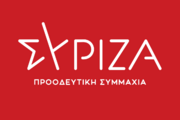 |
|
| Website | |
| Lua error in Module:European_and_national_party_data/config at line 227: attempt to index field 'data' (a nil value). | |
The Coalition of the Radical Left – Progressive Alliance, usually called SYRIZA, is a political party in Greece. It is known for its ideas that are generally considered left-wing or centre-left. The name SYRIZA is a short form of its full Greek name. It also sounds like a Greek word meaning "from the roots" or "radically".
SYRIZA started in 2004 as a group of different left-wing parties working together. In 2012, it officially became a single political party. It supports democratic socialism, which means it believes in a fairer society where everyone has a say. It also supports progressivism, which means it wants to make society better through reforms.
The party is generally in favor of Greece being part of the European Union. SYRIZA also supports LGBT rights and keeping government separate from religion (secularism).
SYRIZA is currently the second largest party in the Hellenic Parliament, which is Greece's main law-making body. Alexis Tsipras, a former leader of SYRIZA, was the Prime Minister of Greece from 2015 to 2019. SYRIZA is part of the Party of the European Left, a group of similar parties across Europe.
After the elections in June 2023, Alexis Tsipras stepped down as leader. Stefanos Kasselakis became the new leader in September 2023. However, there were disagreements within the party, and new leadership elections were held in November 2024. Sokratis Famellos was elected as the new leader.
Contents
How SYRIZA Started
Early Beginnings
SYRIZA officially began in 2004, but its roots go back to 2001. At that time, different left-wing groups in Greece started talking about working together. They had similar ideas on important issues like the Kosovo War, selling off government businesses, and protecting people's rights.
This group helped different parties work together. For example, they opposed changes to the pension system and new anti-terrorism laws. They also wanted to rethink Greece's role in the European Union. Even though it wasn't a political party itself, this group led to some successful election partnerships.
The 2004 Election
A big step for SYRIZA was the 2004 national election. Most of the groups that had been talking decided to form a common plan. This led to the official creation of the Coalition of the Radical Left in January 2004.
The parties that formed this coalition included Synaspismos, the Renewing Communist Ecological Left, and others. These groups came from different backgrounds but agreed on many things.
In the 2004 election, the coalition received 3.3% of the votes. This allowed them to elect six members to parliament. All six were from Synaspismos, which caused some disagreements among the smaller parties in the coalition.
Challenges and Growth
After the 2004 election, there were some tensions within SYRIZA. Smaller parties felt that Synaspismos, the largest party, wasn't keeping its promises. This led to some groups leaving or changing.
However, the crisis ended in December 2004. Most members of Synaspismos voted to continue the coalition. This decision was strengthened when Alekos Alavanos, a strong supporter of the coalition, became the new president of Synaspismos.
The coalition became even stronger after a big European meeting in Athens in 2006. They also had successful local election campaigns. In Athens, Alexis Tsipras led the coalition's ticket, showing a focus on new, younger leaders.
The 2007 Election
In the 2007 national election, SYRIZA was expected to do well. They ended up getting 5.0% of the votes. This was a good increase from their previous results.
Before this election, the parties in the coalition agreed on a shared plan. More groups also joined SYRIZA, including the Communist Organization of Greece and the Democratic Social Movement.
Changes in Leadership

In November 2007, Alekos Alavanos announced he would not continue as president of Synaspismos. In February 2008, Alexis Tsipras was elected as the new president. Tsipras was a municipal councilor at the time, not yet a member of parliament.
Tsipras became very popular with Greek voters. This led to a big increase in support for SYRIZA in public opinion polls.
In the 2009 European Parliament election, SYRIZA's support dropped slightly to 4.7%. This caused more internal disagreements. However, in the 2009 national election, SYRIZA won 4.6% of the vote and elected thirteen members to parliament. Tsipras then became SYRIZA's leader in parliament.
In June 2010, some members left Synaspismos and SYRIZA to form a new party called the Democratic Left. This reduced SYRIZA's number of members in parliament.
2012 Elections and Growth
In 2012, many voters moved away from the parties that had been in government. SYRIZA gained a lot of support. In the May 2012 election, the party received over 16% of the votes. This made them the second largest party in parliament.
After this election, Tsipras tried to form a government but couldn't get enough support from other parties. For the next election in June 2012, SYRIZA officially registered as a single party. This change allowed them to get extra seats in parliament given to the largest party.
In the June 2012 election, SYRIZA increased its votes to almost 27%. However, another party, New Democracy, got more votes and formed the government. SYRIZA became the main opposition party.
Becoming a Single Party
In July 2013, SYRIZA held a big meeting to discuss how the party should be organized. They decided that the different parties within SYRIZA should combine to form one single party. This was a big change.
Alexis Tsipras was confirmed as the chairman of the new, single party. In its founding statement, SYRIZA said it wanted to be a new kind of political group. It aimed to bring together different left-wing ideas and movements. It also wanted to focus on workers' rights, women's rights, and environmental goals.
2014 Elections
In May 2014, Greece held local elections and elections for the European Parliament. In the European Parliament election, SYRIZA came in first place with 26.5% of the votes. This was a big success for the party.
The Thessaloniki Programme
In September 2014, SYRIZA introduced its "Thessaloniki Programme." This was a set of ideas and plans for how they would change Greece's economy and politics if they came to power.
January 2015 Election and Government
In January 2015, Greece held another national election. SYRIZA was leading in the polls. The party's ideas about ending "austerity" (strict government spending cuts) worried some investors.
In this election, SYRIZA won. They became the largest party in the Greek Parliament, getting 36.3% of the votes and 149 out of 300 seats.
On January 26, 2015, Tsipras and the leader of another party, Independent Greeks, agreed to form a government together. Tsipras became the Prime Minister.
Party Changes and 2015 Election
After the SYRIZA government accepted a new agreement about Greece's debt, some members of SYRIZA disagreed strongly. About 25 members of parliament left the party to form a new one called Popular Unity. Many other supporters also left SYRIZA at this time.
Because he had lost his majority in parliament, Tsipras resigned as Prime Minister in August 2015. New elections were called for September 20. SYRIZA won again, getting 145 seats. Tsipras formed another government with the Independent Greeks.
2019 and 2023 Elections
In May 2019, after losing in the European Parliament elections and local elections, Tsipras called for a quick national election. In this election, SYRIZA was defeated by the New Democracy party. SYRIZA then became the main opposition party.
In the May 2023 national election, SYRIZA came in second place. Since no party won enough seats to form a government alone, another election was held in June 2023. SYRIZA's support dropped further, but they remained the second largest party.
After the June 2023 election, Alexis Tsipras resigned as party leader. Stefanos Kasselakis was elected as the new leader in September 2023. Kasselakis said he wanted SYRIZA to become more like the U.S. Democratic Party, moving towards the centre-left.
Recent Changes and Splits
When Stefanos Kasselakis became leader, he started to change some of the party's old ideas. He wanted SYRIZA to be a modern, patriotic, left-wing party. He also wanted to connect directly with voters, sometimes bypassing the party's usual groups.
These changes caused disagreements with some long-time party members. Some members left the party. In November 2023, nine members of parliament and many other members announced they were leaving SYRIZA. These members included former ministers and Efi Achtsioglou, who had run against Kasselakis for leader. Those who left later formed a new party called New Left.
In the 2024 European Parliament election, SYRIZA's support continued to fall. However, because the leading party, New Democracy, also lost some support, SYRIZA managed to reduce the gap between them.
In September 2024, 100 members of SYRIZA's central committee asked for new leadership elections. They felt that Stefanos Kasselakis was moving the party too far to the right. The next day, 163 members supported this idea, and Kasselakis was removed from his position.
New leadership elections were held in November 2024. Sokratis Famellos was elected as the new leader of SYRIZA. Stefanos Kasselakis left SYRIZA and started a new party called the Movement for Democracy. This led to more members of parliament leaving SYRIZA.
What SYRIZA Believes In
SYRIZA started by bringing together many different left-wing groups. Its main founding party, Synaspismos, was a democratic socialist party. This means they believe in a society where everyone is equal and has a say, and where the government helps people.
SYRIZA is influenced by ideas like the "democratic road to socialism." This means they believe in achieving a fairer society through peaceful, democratic ways. The party includes people with different ideas, like those who follow Marxism (ideas about class struggle and economic systems) and Trotskyism (another type of Marxism).
Even though SYRIZA generally believes in keeping government separate from religion, many members are Christians. They are against the special privileges of the state-supported Church of Greece.
In the past, SYRIZA was seen as a party that challenged the existing system. It was described as a left-wing populist party, meaning it appealed directly to ordinary people against the powerful. While it once talked about possibly leaving the euro currency, its leaders later said they did not support leaving the eurozone.
After being in government, SYRIZA became more pro-Europeanist. This means they supported Greece's role in the European Union. By 2019, some people saw SYRIZA as a more mainstream centre-left party. Its goal was to build a broad group of progressive forces without giving up its core left-wing ideas.
During its time in government, SYRIZA faced tough choices. Despite its strong anti-austerity promises, it had to implement some spending cuts. This was a difficult period for the party.
Internal Groups
SYRIZA has had different groups within it, even after becoming a single party.
- Group of 53/Umbrella: This group formed in 2014. They were often seen as a middle ground between the party's far-left members and the main leadership. Many members of this group later left SYRIZA in November 2023 to form the New Left Party.
- Left Platform: This group was on the far-left of SYRIZA. In August 2015, 25 members of parliament from this group left SYRIZA. They formed a new party called Popular Unity because they disagreed with the government's debt agreement.
Past Member Parties
SYRIZA became a single party by combining many smaller groups. Here are some of the main ones:
- Synaspismos: This was the main party that formed the backbone of SYRIZA. It helped bring together many different left-wing groups.
- Renewing Communist Ecological Left (AKOA): This party was founded in 1987 and was part of the Eurocommunist Left. It joined SYRIZA at the beginning.
- Movement for the Unity of Action of the Left (KEDA): This group was formed by people who left the Communist Party of Greece. It joined SYRIZA in 2004.
- Internationalist Workers' Left (DEA): This group focused on revolutionary Marxism. It was involved in important SYRIZA projects like the Sunday School for Immigrants.
- Active Citizens: This group was founded by the well-known left-wing leader Manolis Glezos. It joined SYRIZA in 2004.
- Communist Organization of Greece (KOE): This Marxist-Leninist group supported SYRIZA in 2004 and officially joined in 2007.
- Democratic Social Movement (DIKKI): This party joined SYRIZA in 2007.
- Start – Socialist Internationalist Organisation: This Trotskyist group joined the coalition in 2008.
- Roza: A group of libertarian leftists who joined SYRIZA in 2013.
- Ecosocialists of Greece: This environmentalist party joined SYRIZA in 2008.
- Anticapitalist Political Group (APO): A Trotskyist group active in trade unions, it joined SYRIZA in 2009.
- Unitary Front: A centre-left group that joined SYRIZA in 2012.
- Union of the Democratic Centre: A historic moderate party that joined SYRIZA in 2012.
- Citizens' Association of Rigas: This group teamed up with SYRIZA in the 2012 elections.
- New Fighter: A social democratic group that joined SYRIZA in 2012.
Election Results
Hellenic Parliament Elections
| Election | Hellenic Parliament | Rank | Government | Leader | ||||
|---|---|---|---|---|---|---|---|---|
| Votes | % | ±pp | Seats won | +/− | ||||
| 2004A | 241,539 | 3.3% | +0.1 |
6 / 300
|
4th | Opposition | Nikos Konstantopoulos | |
| 2007 | 361,211 | 5.0% | +1.7 |
14 / 300
|
4th | Alekos Alavanos | ||
| 2009 | 315,627 | 4.6% | –0.4 |
13 / 300
|
5th | Alexis Tsipras | ||
| May 2012 | 1,061,265 | 16.8% | +12.2 |
52 / 300
|
2nd | |||
| Jun 2012 | 1,655,022 | 26.9% | +10.1 |
71 / 300
|
2nd | |||
| Jan 2015B | 2,245,978 | 36.3% | +8.5 |
149 / 300
|
1st | Coalition government (SYRIZA–ANEL) |
||
| Sep 2015 | 1,925,904 | 35.5% | –0.8 |
145 / 300
|
1st | Coalition government (SYRIZA–ANEL) |
||
| 2019 | 1,781,174 | 31.5% | –4.0 |
86 / 300
|
2nd | Opposition | ||
| May 2023 | 1,184,500 | 20.1% | –11.4 |
71 / 300
|
2nd | Snap election | ||
| June 2023 | 929,373 | 17.8% | –2.3 |
47 / 300
|
2nd | Opposition | ||
A 2004 results are compared to the Synaspismos totals in the 2000 election.
B January 2015 results are compared to the combined totals for Syriza and OP totals in the June 2012 election.
European Parliament Elections
| European Parliament | ||||||||
|---|---|---|---|---|---|---|---|---|
| Election | Votes | % | ±pp | Seats won | +/− | Rank | Leader | EP Group |
| 2009A | 240,898 | 4.70% | +0.54 |
1 / 22
|
5th | Alexis Tsipras | GUE/NGL | |
| 2014 | 1,518,608 | 26.56% | +21.86 |
6 / 21
|
1st | |||
| 2019 | 1,204,083 | 23.75% | –2.81 |
6 / 21
|
2nd | The Left | ||
| 2024 | 593,133 | 14.92% | -8.83 |
4 / 21
|
2nd | Stefanos Kasselakis | ||
A 2009 results are compared to the Synaspismos totals in the 2004 election.
European Parliament Members
As of June 2024, SYRIZA has four members in the European Parliament. These members are:
- Elena Kountoura
- Kostas Arvanitis
- Nikos Pappas
- Nikolas Farantouris
Party Structure
Symbols
From 2004 to 2020, SYRIZA used flags with three colors: red (for socialism), green (for ecology), and purple (for feminism). In 2020, the party changed its logo and symbol. The new symbol is a star made from the Greek letters "Σ" and "Υ", which are the first letters of SYRIZA.
Party Leaders
| No. | Leader | Portrait | Term of office | Prime Minister | ||
|---|---|---|---|---|---|---|
| 1 | Nikos Konstantopoulos | 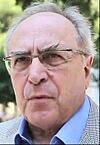 |
15 January 2004 | 12 December 2004 | - | |
| 2 | Alekos Alavanos |  |
12 December 2004 | 7 September 2009 | - | |
| 3 | Alexis Tsipras | 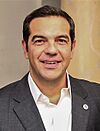 |
7 September 2009 | 29 June 2023 | 2015–2019 | |
| 4 | Stefanos Kasselakis |  |
24 September 2023 | 8 September 2024 | - | |
| 5 | Sokratis Famellos |  |
24 November 2024 | Incumbent | - | |
Images for kids
-
Manolis Glezos during the 2007 elections
See also
 In Spanish: Coalición de la Izquierda Radical para niños
In Spanish: Coalición de la Izquierda Radical para niños


